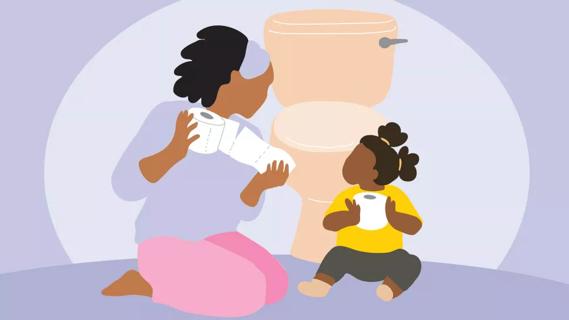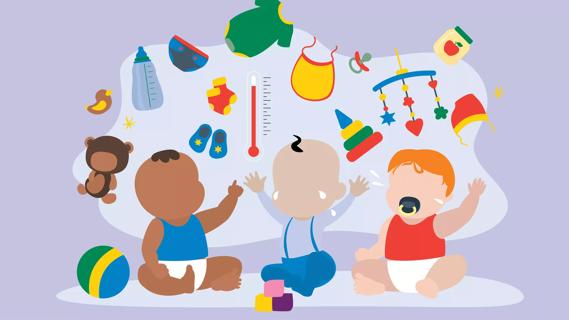Kids aren’t too young to understand or question concepts related to gender

You think you’ve picked up some clues that your child is questioning their gender, but what’s the next step? Should you approach them? Wait for them to come to you?
Cleveland Clinic is a non-profit academic medical center. Advertising on our site helps support our mission. We do not endorse non-Cleveland Clinic products or services. Policy
“Fortunately, more and more kids are recognizing that they’re allowed to question their gender and to feel more comfortable talking about it and playing around with their gender expression,” says child and adolescent psychiatrist Jason Lambrese, MD.
But as a parent or caregiver, you may not be sure how to handle conversations around gender identity and gender expression. Dr. Lambrese delves deeper into how you can support your kids as they explore who they are.
If you’ve ever thought (or been told) that your child is too young to know anything about gender, think again.
“Developmentally, we know that kids as young as 3 years old start understanding and recognizing the concept of gender,” Dr. Lambrese says, “so it shouldn’t surprise us that at a young age, they may start thinking about their own gender.”
Think about it: Nobody bats an eye when young children engage in activities or other forms of expression that are stereotypically associated with the sex they were assigned at birth. If your little boy loves soccer, nobody exclaims, “He’s too young to know that!” If your little boy wants to paint his nails, though, you might hear pushback from people who believe kids can’t possibly have the capacity for gender expression. And that’s just not true.
Using the right terminology to speak about gender and sexuality can help let kids and teens know that you’re in their court. Here are some very basic explanations:
Sex assigned at birth is largely about anatomy. When a baby is born, a doctor proclaims them to be a boy or a girl based on whether they have a penis or a vagina. But as they grow up, a child’s gender identity may or may not align with the sex they were assigned at birth.
Gender identity, however, is who you are inside — your internal sense of your gender. “It’s how you conceptualize your own gender as male or female, or neither, or both,” Dr. Lambrese explains. This is where terms like cisgender, transgender, nonbinary and genderfluid come into play. But it’s something we can’t know about babies until they get older and can start to figure it out for themselves.
Finally, there’s gender expression, which is your public expression of gender, like the clothes and accessories you wear, your body language and even your interests and activities. Many kids don’t yet know their gender identity, but they definitely still have the capacity for gender expression.
That leads us to Dr. Lambrese’s next point…
Kids are in the exploratory stage of life, just figuring out who they are and what they like. That is true when it comes to gender expression, too — but it’s important not to confuse gender expression with gender identity.
“Sometimes, we conflate a kid’s gender identity on the inside with their gender expression on the outside,” Dr. Lambrese clarifies, “and those aren’t always the same thing.”
Here’s an example: Your daughter loves sports, hates dresses and wants to cut her hair super-short — what’s traditionally considered a “tomboy.” All of those things fall under the umbrella of gender expression.
But what’s her gender identity? Well, she may not know yet. Maybe she’s a cisgender girl whose gender expression is more traditionally masculine, or maybe she’ll start to identify as male or nonbinary. But it’s OK for her to live in that gray space as she figures it all out, Dr. Lambrese says.
“Some children who show gender nonconforming behaviors grow up to be transgender, and some don’t,” he adds. “During childhood, it’s important that we aren’t looking at a kid’s gender expression and making an assumption about what their gender identity is.”
When your child hears you speaking openly and positively about a variety of gender identities and sexual orientations, they’re more likely to perceive you as being supportive and accepting of their gender identity and sexual orientation. Here are some tips:
You can foster kids’ exploration and understanding of gender expression by introducing them to a variety of options and letting them choose what they want. This shows them that they can make choices that fall outside the gender binary.
“We tend to subconsciously gender kids by pushing them in a certain direction, like toward stereotypically ‘boy things’ or ‘girl things,’” Dr. Lambrese notes. “Instead, when you go to the store together to buy a new toy, you could say, ‘Hey, do you want to look in the truck aisle or in the doll aisle? Or we could look at both!’”
Halloween is another great example. Instead of suggesting costumes associated with your child’s sex assigned at birth (for example, Thor for boys and Wonder Woman for girls), you can simply ask: “Which superhero do you want to be?” You can also provide options that help them grasp the variety available to them, like, “Do you want to be a pirate or a princess?”
Let’s go back to that toy store example and imagine that, when given the choice, your son picks out a doll.
“Next time he’s playing with it, you might say, ‘Boys can play with dolls if they want, and that’s OK. But some boys who play with dolls actually feel like girls, and that’s OK, too,’” Dr. Lambrese suggests. “You can tell them, ‘If that’s something you ever feel like you want to talk about, we can do that.’”
These types of simple but powerful language show children they’re not alone in thinking about gender and that there’s space for them to be themselves — and still be loved.
It’s great to tell your child that you’re there for them, but it’s even better to continue to tell them on an ongoing basis. When it comes to supporting their gender identity, a one-and-done mention isn’t enough.
“All of the other aspects of life are happening at the same time as their questions about their gender,” Dr. Lambrese says, “so it’s important that you’re having these types of conversations on an ongoing basis.”
As we’ve already discussed, gender expression and gender identity are two different concepts, and kids are in the midst of determining both. Some of what they’re going through now very well could be a phase — and maybe it isn’t.
“Part of being an adolescent is trying on your identity, and identity development is a totally normal developmental stage,” Dr. Lambrese states. “Some teens ‘try on’ an identity that’s different than what they had when they were younger, and for some people, it sticks, while for others, it doesn’t. It’s all part of the journey.”
Using the language that your child requests for themselves — whether it’s a new name or different gender pronouns — is an important demonstration of your support. Several studies show that transgender and gender-nonconforming youths are at lower risk of depression and suicidal ideation when they’re able to freely use their chosen name.
“Choosing a name for yourself can be really important for transgender and nonbinary people, but it’s sometimes a struggle for parents to adjust,” Dr. Lambrese recognizes. He suggests, “In the beginning, you can mentally compare it to the more familiar idea of using a nickname — a sign of respect for who your child is.”
Just be sure to ask your child if they’re comfortable with other people knowing about their new name and pronouns. The last thing you want is to accidentally out them to anyone they don’t want to share the news with yet.
If you need help navigating questions around your child’s gender expression or gender identity, your primary care provider is a great starting point.
“Because they often know your family well, they can be a trusted person to have those conversations with,” Dr. Lambrese says. “They can also connect you with a mental health provider, like a psychologist, a social worker or a counselor, who you can talk to.”
Look for LGBTQIA-affirming providers who are comfortable with and experienced in discussing gender and sexuality. They can provide counseling for gender-questioning children who are dealing with a mental health condition like depression or anxiety. They can also help you understand and explore possible options for your child’s future, like puberty blockers.
“Try reaching out to your local LGBTQ+ community center, too,” Dr. Lambrese advises. “They may offer groups and programming for kids and parents, which can be a helpful option for building community and finding support.”
If you need additional support, especially if your child is experiencing suicidal ideation, call or text the Suicide and Crisis Lifeline at 988 (in the United States) to be connected to a national network of local crisis centers for free and confidential emotional support. Dr. Lambrese also recommends resources from The Trevor Project.
Maybe this one is a no-brainer, but it bears repeating: Letting your child know you love them unconditionally gives them the green light to be open with you about their gender identity — and anything else in life.
Studies show that transgender youth are more likely than their cisgender peers to experience mental health concerns like depression, anxiety and suicidal ideation. But studies also continue to show that parental support can make a huge difference.
“Continue to validate your child when they do anything positive, whether it’s related to gender or not,” Dr. Lambrese urges. “Make sure they continue to hear that you support them and that if there’s ever anything they want to talk to about, you’re here to have those conversations with them.”
Learn more about our editorial process.

Gender exists on a spectrum, with several gender identities to choose from

Knowing how much time your baby should typically go between naps can help keep them on a more regular schedule

Set your child up for potty training success by waiting until they’re ready, keeping the pressure low and going heavy on the praise

In babies under 12 months, honey may cause a serious illness called infant botulism

You can help strengthen your child’s immune system by focusing on hand washing and staying up-to-date on their vaccines

Lanugo — the soft, fine hair that develops in utero — is harmless and will shed within a few weeks

Crossed eyes in a newborn are fairly common, typically harmless and usually go away

A dental emergency, quick action is key to preventing long-term damage

Your metabolism may torch 1,300 to 2,000 calories daily with no activity

A gentle touch in all the right places may help drain your sinuses